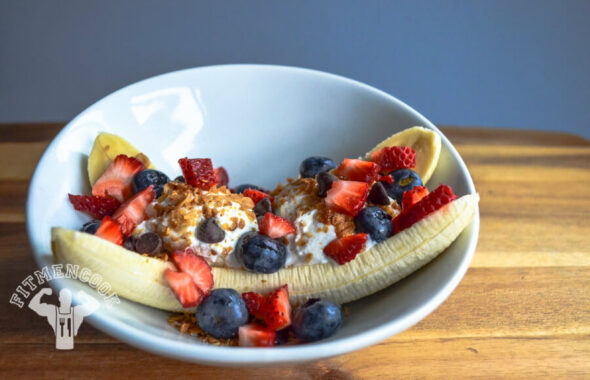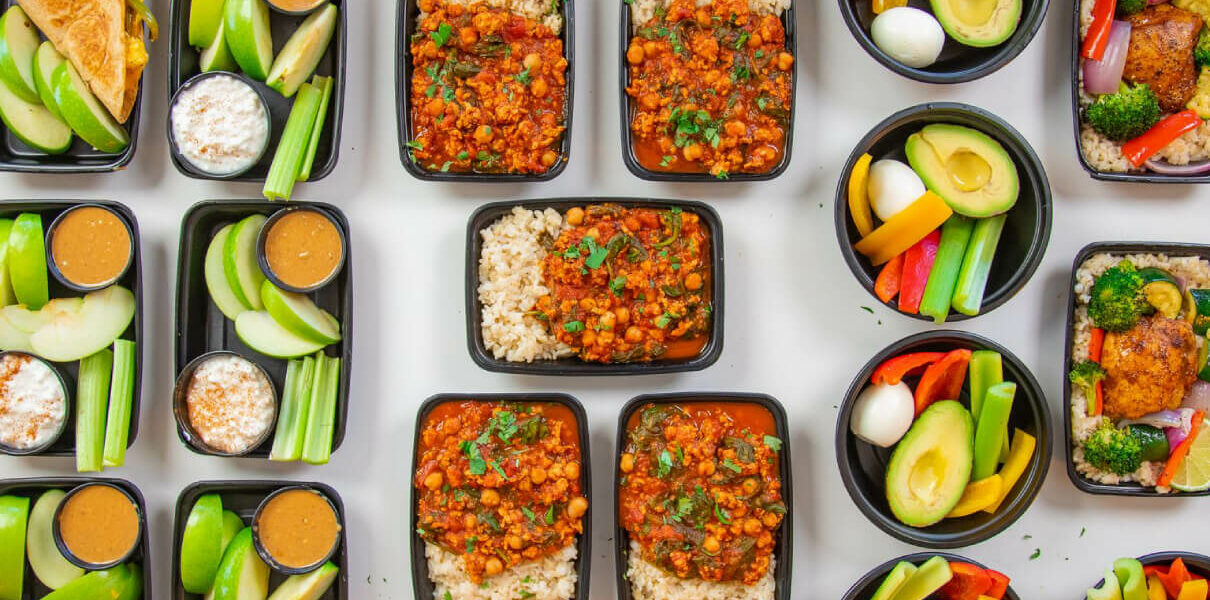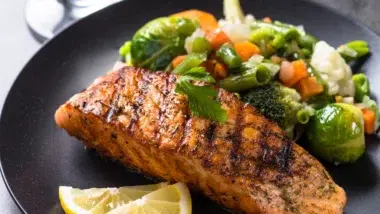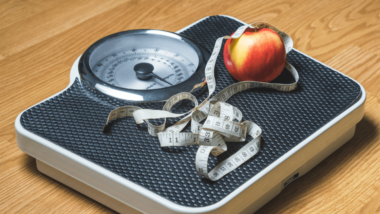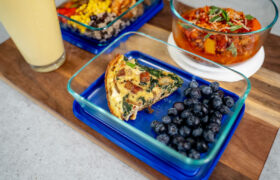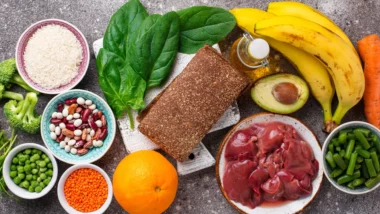Are you looking to gain weight and muscle mass but you’re finding it hard to stick to your goals?
Sure, you could hit the drive-thru for a calorie-packed meal, but when you want that weight to land on your biceps and not your belly, what you eat matters. Meal prepping is the ultimate way to deliver consistent, fast results to achieve your healthy weight gain goals.
If you’ve never heard of meal prepping or you’re not sure how you feel about cooking in your kitchen, jumping into this new style of eating can feel intimidating. But this complete beginner’s guide to meal prep for weight gain will give you a simple step-by-step process that will help you master all of the tips, tricks, and recipes of meal planning.
HOW TO GAIN WEIGHT AND BUILD MUSCLE
Whether you’re looking to bulk up for fitness purposes or recovering from an illness that caused significant weight loss, gaining weight comes down to one simple thing: calories. Eat fewer calories than your body needs, and you’ll lose weight. Eat more calories than your body needs, and you’ll gain weight. Simple as that. But if you want muscle and not just fat, then you need to consider what you eat, how you exercise, and your lifestyle in general.
You can make workout plans and stand goals, but as the food experts in the house, we’ve got some recommendations on what you eat. Here are two important aspects to consider as part of your bulking diet if you want muscle and not just fat: calorie count and macro type.
Below you’ll learn how to master these factors when selecting what to eat. Then we’ll show you how to prepare the food, so it’s convenient for your lifestyle and schedule. This will help you achieve your bulking goals and avoid junk food temptations.
How many calories do you need to gain weight?
The amount of calories you’ll need for weight gain depends on your activity level and your current weight. Following these steps will give you a good target calorie count:
Step 1: Multiply your current weight.
- Men – current pounds x 11
- Women – current pounds x 10
Example for a man currently weighing 190 lbs: 2090 calories
Example for a woman currently weighing: 140 lbs: 1400 calories
Step 2: Multiply that number by your activity level.
- Little or no exercise – x 1.1
- Light exercise 1-3 times a week – x 1.3
- Moderate exercise 6-7 times a week – x 1.5
- Hard exercise 6-7 times a week – x 1.7
- Hard exercise 2+ times a day – 1.9
Example for a man currently weighing 190 lbs with moderate exercise: 3135 calories
Example for a woman currently weighing 140 lbs with moderate exercise: 2100 calories
Step 3: Add calories for weight gain.
If you’re new to muscle building (less than two years of experience), you’ll gain muscle more quickly than someone who has already bulked up and would like to get bigger. Also, if you have a naturally skinny body, you’ll need a different approach than someone starting out with a bit more body fat.
So, the calorie increase is different depending on 1) where you’re at in your muscle-building process and 2) your current percentage of body fat.
New to muscle building:
MEN
| Less than 10% body fat | Add 300 to 1,000 calories |
| More than 10% body fat | Cut 15-20% of calories and eat at least 1 gram of protein per pound of body weight |
WOMEN
| Less than 20% body fat | Add 300 to 1,000 calories |
| More than 20% body fat | Cut 15-20% of calories and eat at least 1 gram of protein per pound of body weight |
2+ year of muscle building experience:
MEN
| Less than 10% body fat | Add 100 to 300 calories |
| More than 10% body fat | Cut 15% of calories and eat at least 1.2 grams of protein per pound of body weight |
WOMEN
| Less than 20% body fat | Add 100 to 300 calories |
| More than 20% body fat | Cut 15% of calories and eat at least 1.2 grams of protein per pound of body weight |
Example for a man currently weighing 190 lbs NEW to moderate exercise: 2508 calories
Example for a woman currently weighing 140 lbs NEW to moderate exercise: 1680 calories
How do you calculate your macros to build muscle?
After you’ve calculated a rough estimate of daily calories for weight gain, you’ll need to understand the macros required when developing lean mass. You know that the drive-thru won’t help you reach your goals – understanding macros will help you know why.
What are macros?
Macros, or macronutrients, are the three types of nutrients that make up most of our foods and provide your body with energy. They are protein, carbohydrates, and fats. The best way to balance your nutrition and reach your weight gain goals is to understand how to count the daily grams of proteins, carbs, or fats that you’re eating. Each of these macros impacts your muscle growth differently – so the right balance between the three is key.
Protein
You’ve probably heard that muscle building requires more protein. Well, that isn’t wrong. Protein is the basic building block of your muscles. So, without adequate protein, your body won’t have what it needs to maintain or increase your muscle mass. Not only is it important to eat enough protein, but consistently eating protein throughout the day in all of your meals and snacks is important for muscle growth and to increase your lean mass.
Carbs
Carbohydrates can get a bad rap, but they’re important for fueling your workouts and ensuring healthy muscle recovery. The key to managing your carb intake is choosing complex carbs when possible. Complex carbs take longer to digest and are a more stable source of energy than simple carbs. Examples of complex carbs include brown rice, oats, black beans, peas, sweet potatoes, butternut squash, broccoli, bell pepper, and berries.
Fats
While you want to prioritize protein and carb intake, fat is a long-lasting energy source and a quick way to boost calories. Each gram of fat is twice as many calories as a gram of protein or carbs. Be careful with your fat intake since increasing your fats can easily lead to fat storage. A balanced diet emphasizes protein and carbs over fats and includes a moderate amount of healthy fats.
Macros determine our energy levels and how quickly we’re able to build lean muscle. They also have a large impact on our overall appetite. Since 5 calories of broccoli will take up a lot more room in our stomach than 5 calories of olive oil, we can use our macro balance to also curb our hunger. For someone looking to lose weight while gaining muscle, including foods like broccoli is the way to go. Those who are needing to gain weight and gain muscle may need to pair that broccoli with more calorie-dense fats to reach the high level of calories needed per day.
How many calories are in each macronutrient?
Protein: 1 gram = 4 calories
Carbohydrates: 1 gram = 4 calories
Fats: 1 gram = 9 calories
How to calculate your macros for muscle gain?
Each body tends to prefer a slightly different ratio of macronutrients. Some people thrive on low-carb diets, while others need slightly higher carb ratios to sustain themselves. The federal dietary recommendations for macronutrient ratios are:
- 45-60% carbs
- 20-35% fats
- Remaining from protein
For someone on a bulking diet, macronutrient ratios tip toward protein and look more like this:
- 35% carbs
- 25% fats
- 40% protein
Example for a man currently weighing 190 lbs NEW to moderate exercise eating 2508 calories per day:
| Carbs: | 878 calories | 220 grams |
| Fats: | 627 calories | 70 grams |
| Protein: | 1003 calories | 251 grams |
Example for a woman currently weighing 140 lbs NEW to moderate exercise eating 1680 calories per day:
| Carbs: | 588 calories | 147 grams |
| Fats: | 420 calories | 47 grams |
| Protein: | 672 calories | 168 grams |
How to calculate your own: (lbs x %) / calories per gram = grams per day
Example: (2508 x 0.35) / 4 calories per gram = 219.45 grams of carbs per day
Tip: A simple way to calculate protein needs for fat reduction and muscle gain is to estimate 1-1.5 grams of protein per pound of body weight. So, a 190-pound man would need 190 to 285 grams of protein per day, which is 760 to 1145 calories.
Remember: Our male and female calorie examples are wanting to lose fat while gaining muscle. If you don’t have fat to lose, your calorie count will be much higher. But you’ll still shift your macro balance to increase protein and reduce fat and carb percentages to ensure lean muscle growth.
THE BEST MEAL PREP FOR MUSCLE GAIN
Now that you’ve got your calories and macros figured out, let’s get some meal prep ideas so you can start cooking. The best meal prep recipe will be one you enjoy eating, fits in your skill-set to cook, and hits your daily calorie and macro goals. That may seem like a lot to pack into one healthy meal, but it’s very doable.
As a general guide, meal times should include lean proteins, nutrient-dense fruits and vegetables, and healthy fats. To avoid gaining unwanted fat on a bulk diet, focus on clean eating – include whole foods and minimize saturated fats, processed foods, and excess sugar.
How to Meal Prep for Muscle Gain
Meal prep, or preparing food in advance, is a great way to have healthy options on hand for any meal or snack. Essentially, you cook once and eat exactly what you need all week. By prepping the meals in advance you can portion out your servings to ensure they hit your calorie and macro goals, making weekday eating less stressful.
Becoming a meal prep pro is easy with these simple steps:
Step 1: Plan
When and what you eat can have a huge impact on your success.
Number of meals
First determine how many meals and snacks you need to prepare. Here are some things to consider:
- You may need to eat more frequently to increase your daily calories.
- Try to include protein throughout your day.
- Depending on how often and hard you’re working out, you may need pre- and post-workout meals.
Select recipes
Make a list of recipes that are rich in protein and will help you correctly balance your macros.
Tips for pre- and post-workout meals:
- Eat a few hours before your workout.
- For morning workouts, use simple sugars for fast-acting energy (ex. muffin or chocolate milk).
- Pre-workout meals for lift days should include more calories, particularly from carbs.
- Post-workout meals should include very little fat while focusing on quick carbs and protein.
Make a calendar
Map out your workout plan for each day. Then assign recipes for each meal and healthy snack needed throughout the week. Keep it simple as you start out – you can eat the same foods each day if needed. But don’t forget to include any snacks, treats, or drinks you’ll want. If you have a cheat day, mark that as well.
Make a grocery list
Write out the ingredients you’ll need and then check your fridge, freezer, and pantry to see what’s missing. Make a grocery list and then hit the store for your missing items.
Track calories and macros
It may seem tedious to write out the numbers, but you’ll thank yourself later if you do all of the calculations upfront. You can also reuse this meal plan, so save all of your calculations somewhere so you only have to do the math once if you choose to repeat a meal plan.
Step 2: Cook
Follow the directions on your recipes. If you’re new to cooking, keep it simple. If cooking is an impossible task for you, consider ordering from a meal prep company to help as you build your cooking skills. Again, for the first little while, consider prepping only a few recipes and using the same meals throughout the week until you’re able to build your confidence in meal prepping and cooking.
Step 3: Store
Portion out your meals in meal prep containers and pop them into the fridge or freezer for later use. Make sure you use containers that fit your needs, including reheating your food later in the week. Food that is stored properly should last in the fridge safely throughout the week. Cooking large batches of a meal is a great way to save time, but make sure meals you cook more than five days in advance are stored in the freezer.
Step 4: Eat
Grab your meals as needed and enjoy with the confidence that you’ve got calories and macros in the bag. Not everyone is a fan of leftovers, so here are a few tips for helping your food taste fresh:
- Reheat using a stovetop or oven when possible.
- Add salt, fresh herbs, and sauces to liven up the flavors.
Recipes for Weight Gain
You have everything you need to get started on meal prep recipes for weight gain. The switch to healthy eating can be a tough lifestyle change, but with the tools listed above, you’re ready to accomplish all of your weight gain goals through meal prepping.
Here are 25 easy meals for healthy cooking to kickstart your meal plan:
Breakfast recipes
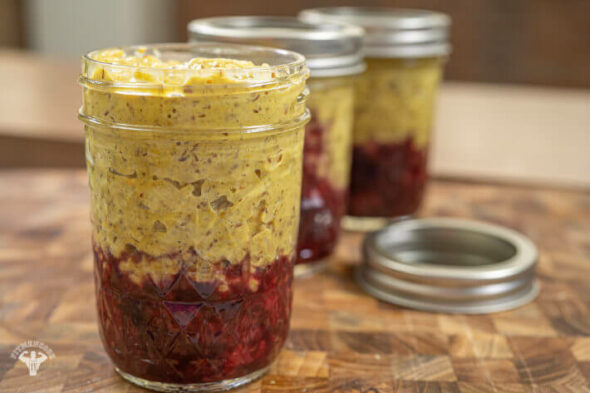
Lunch recipes

White Bean and Mushroom Farro (vegan meal)
Dinner Recipes
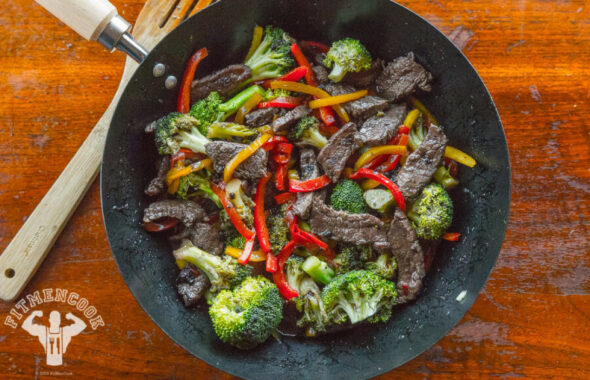
Teriyaki Brussels Sprouts with Salmon
Snack recipes
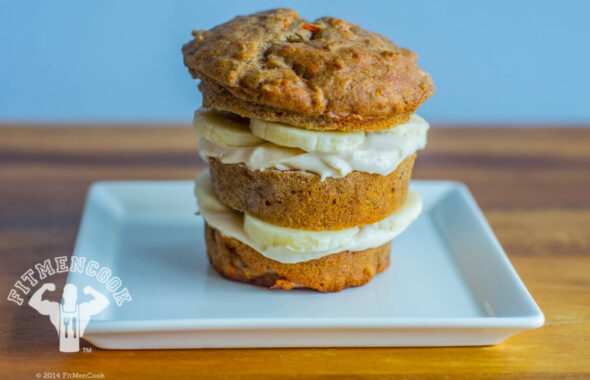
Energy Protein Balls (vegan meal)
Dessert recipes
